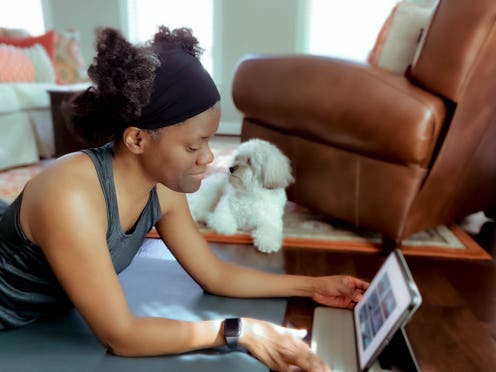Wellness
The Scientific Case For Working Out At Lunchtime
Cheers to that midday sweat.

One of the very, very few silver linings of the COVID-19 pandemic is that it’s afforded people much more flexibility and time for exercising. Newly released data from ClassPass revealed that lunchtime was the most popular time to fit in a workout while people were working from home. And it turns out that midday workout benefits are legit.
“Lunchtime workouts can be a great way to get a start on burning some stored energy throughout the day,” says Gabrielle Tafur, RD, an Orlando, Florida-based dietitian. “Working out at this time can not only help to ease you into bed at night, but it can be a great way to get that midday energy boost you need when it comes to the afternoon slump.”
Generally speaking, exercise helps to reduce stress levels, as well as relieve anxiety and depression symptoms, says Holly Roser, an NASM-certified personal trainer and owner of Holly Roser Fitness in San Francisco. Research has also shown that regular exercise can help to boost work productivity, whereas sitting all day is tied to increased risk of heart disease and Type 2 diabetes.
When you look at studies, there is some evidence that points to midday workouts as the ideal time to get your sweat on. Your body temperature is higher in the late afternoon and evening, for one, which makes it easier for your muscles to move and perform. And a small 2018 study published in Current Biology showed an increase in caloric burn in the late afternoon as opposed to other times of the day, meaning your workout packs more of a punch.
Though you might not have considered a midday workout before — it’s not like last night’s leftovers and jumping jacks make the happiest couple — there are a few practical reasons to consider it. Though Roser suggests her clients to exercise in the morning (she finds that it helps them handle daily stress more easily), it’s not always feasible for those with early work times, kids to get to school, and other a.m. responsibilities. Leaving your workout to the end of the day might not be ideal, either, as exercising before bed can leave you feeling more awake, Tafur adds. All the more reason to try out a lunchtime workout.
Of course, you might be wondering, "What about the lunch part of the lunchtime workout?" Roser recommends having a light snack before you exercise and then eating your full lunch after. “You can refuel midday with a decent size-portioned lunch without feeling sluggish afterward,” she says. Make sure to eat something before working out, too: “Not eating at all can make you feel weak during a workout, which can be detrimental to the efforts you’re putting in,” adds Tafur.
So if midday is the most realistic time for you to get your sweat on, know that it’ll be helping your body out in more ways than you ever realized.
Studies referenced:
Biswas, A. (2015). Sedentary time and its association with risk for disease incidence, mortality, and hospitalization in adults. Annals of Internal Medicine, https://www.acpjournals.org/doi/10.7326/M14-1651
Schwarz, U. (2011). Employee self-rated productivity and objective organizational production levels: effects of worksite health interventions involving reduced work hours and physical exercise. Journal of Occupational and Environmental Medicine, https://pubmed.ncbi.nlm.nih.gov/21785369/
Zitting, K-M. (2018). Human resting energy expenditure varies with circadian phase. Current Biology, https://www.cell.com/current-biology/fulltext/S0960-9822(18)31334-4
Experts:
Holly Roser, NASM-certified personal trainer and owner of Holly Roser Fitness in San Francisco
Gabrielle Tafur, RD, an Orlando, Florida-based dietitian
This article was originally published on